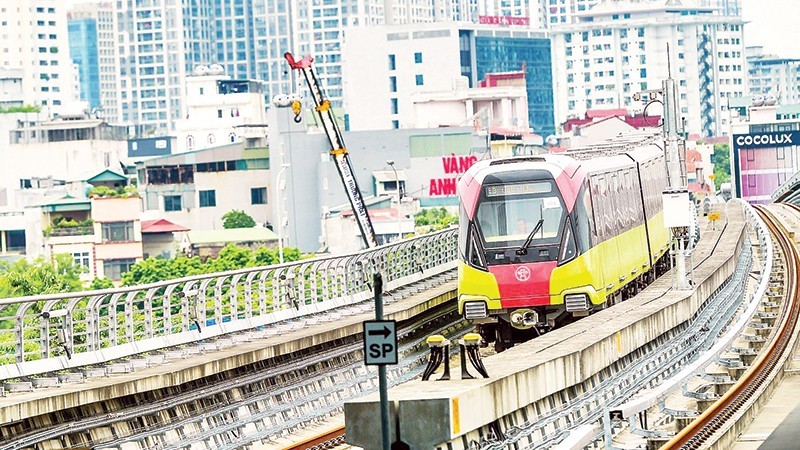With the implementation of many new types of transportation, Ha Noi is gradually greening public transportation. However, for this goal to be achieved faster and more effectively, there are still many policy and resource difficulties, that need to be resolved soon.

Urban railway line No. 3, the elevated section of the Nhon-Cau Giay Station urban railway line, is being tested to prepare for operation in the near future.
Just launched at the end of August, the public bicycle service in Ha Noi has quickly attracted many users. Nguyen Thu Huyen, residing in Hoan Kiem district, said that using public bicycles is very convenient, because they can be rented and returned everywhere, the price is cheap, suitable for many people, as well as the roads in Hanoi. "Since launching public bicycles, I often use this means of transportation every day. On days when the weather is favourable, I use public bicycles to go to work," Huyen shared.
Do Ba Dan, Chairman of the Board of Directors of Tri Nam Group said, that in the first phase, the enterprise put into operation 1,000 vehicles, including 500 electric bicycles and 500 mechanical bicycles, at 79 locations in many inner city areas. Bicycle stations are located at bus stops, parks, and tourist attractions, ensuring people have convenient access to services, he added.
With such convenience, after only half a month of operation, the public bicycle service in Ha Noi has had more than 36,000 new accounts opened; 25,208 public bicycle trips were operated with 163,600 km, total rental hours were 25,649 hours.
With the introduction of bicycles, Ha Noi is gradually concretising the goal of "greening" public transportation. According to environmental experts, in order to improve air quality in a sustainable way, developing green transportation is essential, helping to limit emissions of CO2 and other harmful emissions into the environment.
Because the green transportation uses renewable energy, electricity, and compressed natural gas, the use of electric bicycles, electric motorbikes, electric cars; CNG-powered vehicles, vehicles using solar energy and wind energy, is pushing the green transport system, ensuring environmental sustainability.
Clearly identifying this goal, Ha Noi has focused on investment and has so far achieved positive results. That is the investment in construction and putting into use the Cat Linh - Ha Dong urban railway; Ten electric bus routes and seven bus routes using CNG-powered vehicles.
Recently, Ha Noi Transport Corporation also signed a cooperation agreement with a Russian enterprise, preparing to launch many other clean bus routes. Along with that, the city has licensed the operation of thousands of electric taxis; Introducing public bicycles and electric bicycles, to serve the travel needs of people in some inner-city districts.
By the end of this year, the Nhon - Cau Giay section of railway line No.3 is expected to be put into operation, further increasing the share of green public transportation.
According to leaders of the Department of Transport, despite facing numerous difficulties and challenges, Hanoi is undeniably moving in the right direction, in transitioning to sustainable public transportation methods. The adoption of green vehicles in public transport not only actively contributes to environmental protection but also appeals to passengers, gradually shifting their preference from private cars to trains and buses.
Le Thanh Hai (Thuy Khue ward, Tay Ho district) said that electric trains offer the advantage of high speed, whereas buses and electric taxis are somewhat affected by traffic congestion. However, these transportation modes share the common attribute of being clean, orderly, and providing a more comfortable experience, compared to gasoline or diesel-powered trains. Consequently, they are gaining popularity among passengers. I personally switched to using electric buses when they became available.
Not to mention electric buses, taxis and public electric bicycles, when connected to urban railways, will be much more effective, convenient and modern. Types of public passenger transport using clean fuel, not only complement each other in terms of connectivity and transportation, but are also contributing to forming a green transportation ecosystem.
According to many experts, to build HaNoi into a civilized, modern city, a place worth living with a green transportation network, the first resource needed is policy. Among them, issues such as limiting personal vehicles, investing in public transport; developing vehicles running on clean fuel; popularizing bicycles or encouraging people to walk, requires clear, specific and appropriate policies.
The city needs to increase more incentives to encourage public passenger transport businesses to use vehicles powered by natural gas and electricity.
In addition, the city needs to have more policies to attract social resources to invest in urban railways and other types of green vehicles. Only then will public passenger transport truly attract passengers and realise the goal of building green transportation for the capital.
Quoc Toan - Translated by NDO